DOI:
10.1039/D1RA03083C
(Paper)
RSC Adv., 2021,
11, 19294-19309
Retracted Article: Effectiveness of some novel heterocyclic compounds as corrosion inhibitors for carbon steel in 1 M HCl using practical and theoretical methods†
Received
20th April 2021
, Accepted 7th May 2021
First published on 27th May 2021
Abstract
Corrosion of carbon steel is a major problem that destroys assists of industries and world steel installations; the importance of this work is to introduce new heterocyclic compounds as effective and low-cost corrosion inhibitors. Three compounds of carbohydrazide derivatives, namely: 5-amino-N′-((2-methoxynaphthalen-1-yl)methylene)isoxazole-4-carbohydrazide (H4), 2,4-diamino-N′-((2-methoxy-naphthalene-1-yl)methylene) pyrimidine-5-carbohydrazide (H5) and N′-((2-methoxynaphthalen-1-yl)methylene)-7,7-dimethyl-2,5-dioxo-4a,5,6,7,8,8a-hexahydro-2H-chromene-3-carbohydrazide (H6) were used to examine the efficacy of corrosion of carbon steel in 1 M hydrochloric acid solution. This corrosion efficacy was detected by utilizing various methods including electrochemical impedance spectroscopy (EIS), potentiodynamic polarization (PDP), weight loss measurements (WL), surface morphology analyses by atomic force microscopy (AFM), quantum chemical computations based on density functional theory (DFT) and molecular dynamics (MD) simulation. The results indicated that these compounds act as mixed type inhibitors i.e. reduce the corrosion rate of carbon steel due to the formation of a stable protective film on the metal surface and reduce the cathodic hydrogen evolution reaction. As confirmed from impedance, carbohydrazide derivatives molecules are adsorbed physically on metal surface with higher corrosion efficacy reached to (81.5–95.2%) at 20 × 10−6 M concentration at room temperature. Temkin isotherm model is the most acceptable one to describe the carbohydrazide derivative molecules adsorption on the surface of carbon steel. Protection mechanism was supported by quantum chemical analyses and Monte Carlo modeling techniques. The theoretical calculations support the experimental results obtained. This proves the use of carbohydrazide derivatives as a very effective inhibitors against the corrosion of carbon steel in acidic media.
1 Introduction
Carbon steel is an essential material for many applications such as factories structures and petroleum pipelines. These structures may be contacted with various solvents that can affect their consistency and durability through aggressive behavior, which ultimately lead to carbon steel corrosion and destruction, especially in acidic media. The cost of corrosion has been estimated at $276 billion per year in the United States.1 Heterocyclic organic compounds which contain multiple bonds and heteroatoms, such as O, N or S are excellent corrosion inhibitors because it could be adsorbed on the metal surface through these heteroatoms.2 The adsorbance of such compounds on the metal surface blocks active sites and reduces the rate of corrosion. However, the effectiveness of the inhibitor depends on the physical and chemical properties of the inhibitor structure, due to the existence of specific functional groups, aromaticity, electronic density, kind of corrosive solution and the structure of the inhibitor.3–8 Because of its use in numerous industries, the study of organic corrosion inhibitors is a fruitful area of science. The most important result of corrosion inhibition is the control of risks that can arise from decreasing in metal thickness in tanks and pipelines which results in a material leakage and severe consequences as fires and explosions. In other words, the corrosion inhibition increases safety and environmental protection issues.9 Many researches have been approved that many heterocyclic compounds such as hydrazide derivatives have a better inhibition role on carbon steel in acidic medium.10 The hydrazide derivatives have various applications in medicine and engineering fields. Hydrazides derivatives have been elucidated their effectiveness as anticancer, antibacterial, anti-inflammatory, analgesic and antioxidant factors.11 Furthermore, they are also used as effective inhibitors for mitigation of corrosion for various metals as carbon steel. Many scientists as Fouda et al.12 and Agarwal et al.13 has studied various hydrazide derivatives and proved their effective corrosion inhibition efficacy, some of the investigated compounds were followed Temkin isotherm and the others were followed Langmuir isotherm.14–16 In continuation to our previous study,17 the objective of this research is to examine the effectiveness of three newly synthesized hydrazide derivatives as carbon steel corrosion inhibitors by introducing various electron donating atoms such as N and O atoms or donating group such as (CH3) and (OH) in these compounds. The investigated compounds are similar in the structure in the hydrazide nucleus but differ in the substituents that affect the compounds inhibition abilities. The corrosion inhibition of the investigated compounds was further deduced using quantum chemical calculations and Monte Carol simulations techniques.
2 Materials and methods
2.1 Preparation of inhibitors
The investigated compounds were synthesized as described before18,19 and are listed in Table 1. All the structures of the prepared compounds were elucidated by elemental analysis 1H-NMR, 13C-NMR, and mass spectral data.
Table 1 Nomenclature, structures, molecular formulas, and molecular weights of (H4 & H5 & H6)
| Code |
Name |
Structure |
M.F |
M.Wt |
| H4 |
5-Amino-N′-((2-methoxynaphthalen-1-yl)methylene)isoxazole-4-carbohydrazide |
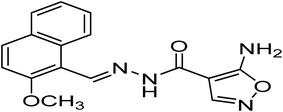 |
C16H44N4O3 |
310.3 |
| H5 |
2,4-Diamino-N′-((2-methoxynaphthalen-1-yl)methylene)pyrimidine-5-carbohydrazide |
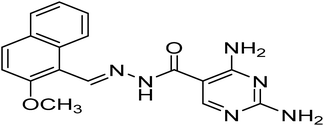 |
C17H46N6O2 |
336.3 |
| H6 |
N′-((2-Methoxynaphthalen-1-yl)methylene)-7,7-dimethyl-2,5-dioxo-4a,5,6,7,8,8a-hexahydro-2H-chromene-3-carbohydrazide |
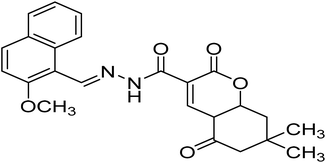 |
C24H24N2O5 |
420.4 |
- (0.0001 g) of each inhibitor was dissolved in 3 ml of dimethylformamide (DMF) then completed with absolute ethyl alcohol 99.5% to 100 ml stock solution. Then this stock was used to prepare the applicable concentrations (1 × 10−6, 2 × 10−6, 5 × 10−6, 10 × 10−6, 15 × 10−6 and 20 × 10−6 M) using dilution equations.
- Note: these concentrations is the best applicable concentrations, all concentrations lower than 1 × 10−6 did not give a considerable inhibition efficiencies, on the other side, the inhibition efficiencies did not increase when the concentration of inhibitors was raised higher than 20 × 10−6.
The applied corrosive medium was 1 M HCl. Sodium bicarbonate was used to titrate HCl using methyl orange as indicator.
2.2 Carbon steel sheets
All experiments were done by carbon steel sheets with dimensions 1 × 1 × 0.2 cm approximately. Carbon steel composed mainly of iron with traces of some different elements (wt%): (0.06% Si, 0.001% Ti, 0.022% P, 0.08% C 0.010% S, 0.030% Al, 0.3% Mn).20 Working electrode for electrochemical experiments were made of carbon steel piece (area of 0.5 cm2) attached by welding to a bar of copper and covered with glass. The auxiliary anode was a platinum layer (1 cm2), the saturated calomel electrode is the reference electrode (SCE).
2.3 Methods used for corrosion calculations
2.3.1 Weight loss (WL) method. Weight loss measurements were done using carbon steel sheets measuring 1 × 1 × 0.2 cm. These sheets were first abraded carefully with (400, 600, 800 and 1200 grit size) coarseness emery sheet, washed and dried with bidistilled water before being weighed and sunk into 1 M HCl glass beakers of 100 ml + gradual concentrations of (H4 & H5 & H6). Glass beakers were put in a water bath with an automatic thermostat to achieve experiments in different temperatures; all experiments allowed to air. Sheets were removed from beakers every 30 minutes for 3 hours, washed with distilled water, dried, and weighed exactly. Weight loss was estimated for each period, degree of surface coverage (θ) and inhibition efficiency (% IE) of (H4 & H5 & H6) was determined from eqn (1):| | |
% IE = θ × 100 = [(W − W)/W0] × 100
| (1) |
where W and W0 are the values of the weight loss in the presence and absence of the inhibitors, respectively.
2.3.2 Electrochemical measurements.
2.3.2.1 Potentiodynamic polarization (PDP) method. The PDP experiments were conducted in a three-electrode cell, a carbon steel sheet working electrode (WE) attached to a copper bar and covered with glass, a reference electrode (saturated calomel electrode) (SCE) and a counter electrode platinum plate (CE). In each run, 100 mL beakers of 1 M HCl were examined without and with the addition of gradual inhibitor concentrations. The study was carried out using Potentiostat/Galvanostat/ZRA (Gamry reference 3000), and the experiment was configured with electrochemical software provided by a computer. The working electrode were adjusted for at least 30 min to achieve the equilibrium before measurements. The polarization drawings were carried out by sweeping the electrode potential below 1 mV s−1 sweep rate and under air environment in the range from −500 to +500 mV versus open circuit potential. The cathodic branch of the Tafel curve was extrapolated to the corrosion potential, Ecorr, for the measurement of corrosion current densities. The tests were performed with gradual inhibitor concentrations at 25 °C. The level of surface coverage (θ) and percentage of inhibition efficiency (IE%) is measured from eqn (2):| | |
% IE = θ × 100 = [Icorr − Icorr(inh)/Icorr] × 100
| (2) |
where Icorr(inh) and Icorr are the inhibited and uninhibited corrosion current density, respectively.
2.3.2.2 Electrochemical impedance spectroscopy (EIS) method. The experimental EIS were estimated after open circuit potential (OCP) measurement using the equivalent circuit. The EIS measurements was carried out between 1 Hz to 100 kHz frequency, the perturbation was conducted with signal amplitude 10 mV. Essential parameters deduced from Nyquist graph (that is produced from computer program-Gamry) are the impedance Rp and the double layer capacitance Cdl,21 Bode diagrams were also drawn. % IE was got from the eqn (3) and Cdl was got from eqn (4):| | |
% IE = [1 − (R0p/Rp)] × 100
| (3) |
where R0p and Rp are the polarization resistances without and with the inhibitor, respectively,where fmax is the angular frequency; Cdl is the double layer capacitance.
2.3.3 Atomic force microscopy (AFM) analysis. AFM is a device generates a topographic surface maps with a unique resolution, so the outer surface roughness can be measured; the surface roughness is caused due to deviations of a surface from its ideal shape due to corrosion or inhibitor adsorption. AFM device model is Pico SPM2100 operating in contact mode in air at Nanotechnology Laboratory, Faculty of Engineering Mansoura University. Five sheets of clean carbon steel were prepared, the first was taken as a free reference (not subjected to inhibitors or HCl), the second was immersed in HCl only for 24 hours and the remaining three sheets were immersed in 1 M HCl + the optimal concentration of each inhibitor (20 × 10−6 M) for 24 hours.
2.3.4 Fourier transform infrared (FT-IR) analysis. FT-IR spectrum was performed in a PerkinElmer 1600 spectrophotometer for pure solutions of (H4 & H5 & H6) and for carbon steel sheets that were immersed in 1 M HCl + the optimal concentration of each inhibitor for 24 hours.
2.3.5 X-ray photoelectron spectroscopy (XPS) examination. This test was achieved by a highly efficient device that determines the binding energies of different bonds found on the carbon steel surface that were immersed in 1 M HCl + the optimal concentration of each inhibitor for 24 hours using (XPS), hence the adsorbed atoms and functional groups on metal surface could be deduced. XPS test was done by K-ALPHA (Thermo Fisher Scientific, USA).
2.3.6 Quantum chemical calculations. Calculation method done by Material studio Dmol6 DFT software, GGA basis Set RPBE. Parameters (global and local indicators) were calculated as highest occupied molecule orbital (HOMO) and lowest occupied molecule orbital (LUMO), dipole moment (μ), energy gap (ΔE), total hardness (η), absolute electronegativity (χ), transferred electron fraction (ΔN), and softness (σ), using the DFT method.These eqn (5)–(10) were used in the calculations:22
| | |
Pi = (ELUMO − EHOMO)/2
| (8) |
where
φ is the work function of the metal surface (
φFe = 4.81 eV).
2.3.7 Monte Carlo simulation. The interaction between the three investigated hydrazide derivatives and the carbon steel surface (CS) was studied using Monte Carlo simulations. To interpret the more adapted metallic surfaces for the simulations process, Monte Carlo simulation method was used Materials Studio 2017.The adsorption energy (Eads) of each inhibitor molecule was calculated as:23
| | |
Eads = Ecomplex − (Einh + ECS)
| (11) |
where
Ecomplex,
Einh, and
ECS represent the total energy of the optimized inhibitor –CS complex, the isolated inhibitor molecule, and the CS crystal, respectively.
3 Results and discussions
3.1 Weight loss (WL) tests
Weight loss tests were conducted for (H4 & H5 & H6) compounds and the corrosion rates of carbon steel were estimated. Fig. 1 illustrates a change of WL in the absence and presence of gradual concentrations of H4 at 25° for example. The curves for H2 & H3 are not shown. The (θ) and inhibition efficacy (% IE) were illustrated in Table 2. As shown from the table, the % IE raises with increasing hydrazide derivative concentrations which mean that more hydrazide derivative molecules were adsorbed on the surface which increases the surface coverage. For example, the ideal concentration needed to provide inhibition efficacy (% IE) of 93.1% was seen at 20 × 10−6 M for H4 inhibitor.
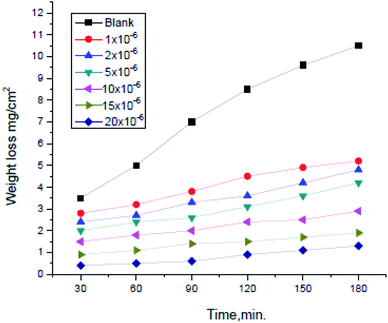 |
| | Fig. 1 Weight loss vs. time curves for the corrosion of carbon steel in 1.0 M HCl with and without altered concentrations of compound (H4) at 25 °C. | |
Table 2 Weight loss tests for (H4 & H5 & H6) at 25 °C [corrosion rate (C.R.), surface coverage (θ) and inhibition efficacy (% IE)]
| Compound |
Concentration (M) |
C.R. (mg cm−2 min−1) |
θ |
% IE |
| |
Blank |
0.082 ± 0.0017 |
— |
— |
| H4 |
1 × 10−6 |
0.040 ± 0.0022 |
0.512 |
51.2 |
| 2 × 10−6 |
0.037 ± 0.0020 |
0.551 |
55.1 |
| 5 × 10−6 |
0.033 ± 0.0018 |
0.603 |
60.3 |
| 10 × 10−6 |
0.021 ± 0.0023 |
0.738 |
73.8 |
| 15 × 10−6 |
0.015 ± 0.0012 |
0.815 |
81.5 |
| 20 × 10−6 |
0.010 ± 0.00024 |
0.883 |
88.3 |
| H5 |
1 × 10−6 |
0.054 ± 0.0022 |
0.342 |
34.2 |
| 2 × 10−6 |
0.042 ± 0.0015 |
0.486 |
48.6 |
| 5 × 10−6 |
0.036 ± 0.0019 |
0.567 |
56.7 |
| 10 × 10−6 |
0.026 ± 0.00210 |
0.683 |
68.3 |
| 15 × 10−6 |
0.023 ± 0.00240 |
0.719 |
71.9 |
| 20 × 10−6 |
0.012 ± 0.00028 |
0.853 |
85.3 |
| H6 |
1 × 10−6 |
0.051 ± 0.00230 |
0.384 |
38.4 |
| 2 × 10−6 |
0.042 ± 0.00200 |
0.482 |
48.2 |
| 5 × 10−6 |
0.036 ± 0.00180 |
0.561 |
56.1 |
| 10 × 10−6 |
0.024 ± 0.00120 |
0.703 |
70.3 |
| 15 × 10−6 |
0.010 ± 0.00110 |
0.875 |
87.5 |
| 20 × 10−6 |
0.004 ± 0.00016 |
0.952 |
95.2 |
As shown from Fig. 1, the curves in inhibitors presence were found below that of its absence. Also, the curves are approximately straight lines due to the absence of oxide film or any corrosion product on the steel surface.
3.1.1 Adsorption isotherms. (H4 & H5 & H6) inhibitors has shown protection from oxidation of carbon steel in the corrosive medium by adsorption on its surface because the binding energy between the H2O molecules and the outer surface is lower than that between the molecules of the inhibitor and the surface of the metal24 as determined in eqn (12):| | |
xH2Oads + Orgsol ↔ Orgads + xH2O
| (12) |
where x is the amount of single organic molecules substituted for H2O molecules. The molecules on the outer surface of a metal can be physiosorbed or chemisorbed. By minimizing the cathodic response, the physiosorbed molecules face metal corrosion, while chemisorbed molecules impede the anodic response by decreasing the possible reaction of the corroding metal at the sites of adsorption.25 After examination of all adsorption isotherms we conclude that the best isotherm that fits our results is Temkin isotherm26 as determined in eqn (13):| |
aθ = ln![[thin space (1/6-em)]](https://www.rsc.org/images/entities/char_2009.gif) KC KC
| (13) |
where C is the concentration (M) of (H4 & H5 & H6); K is the adsorption equilibrium constant, (a) is a molecular interaction parameter. A graph of θ against log![[thin space (1/6-em)]](https://www.rsc.org/images/entities/char_2009.gif) C gives straight lines as appeared in Fig. 2, note: slope = 2.303/a, intercept = 2.303/a
C gives straight lines as appeared in Fig. 2, note: slope = 2.303/a, intercept = 2.303/a![[thin space (1/6-em)]](https://www.rsc.org/images/entities/char_2009.gif) log
log![[thin space (1/6-em)]](https://www.rsc.org/images/entities/char_2009.gif) Kads. Thermodynamic parameters of adsorption were calculated and tabulated in Table 3. The essential parameters were calculated are
Kads. Thermodynamic parameters of adsorption were calculated and tabulated in Table 3. The essential parameters were calculated are  ,
,  and
and  after assessment of Kads at various temperatures (Fig. 2).27 The change in free energy can be calculated from eqn (14):
after assessment of Kads at various temperatures (Fig. 2).27 The change in free energy can be calculated from eqn (14):| |
 | (14) |
where 55.5 is the amount of H2O in mol L−1, T is the temperature and R is the universal gas constant.  ,
,  can be determined from eqn (15):
can be determined from eqn (15):| |
 | (15) |
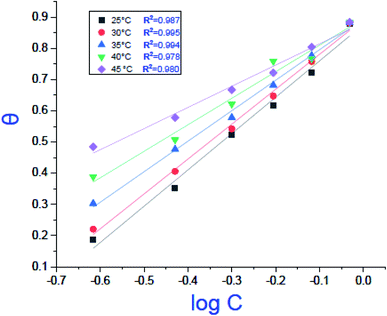 |
| | Fig. 2 Temkin adsorption isotherm of compound (H4) on carbon steel surface in 1.0 M HCl at various temperatures. | |
Table 3 Thermodynamic parameters for the adsorption of (H4 & H5 & H6) derivatives on carbon steel surface in 1 M HCl at different temperatures
| Compound |
T (°C) |
Kads (M−1) |

|

|

|
| H4 |
25 |
5.67 |
14.25 |
48.81 |
171 |
| 30 |
6.29 |
14.75 |
48.81 |
| 35 |
8.21 |
15.68 |
48.81 |
| 40 |
11.33 |
16.77 |
48.81 |
| 45 |
20.03 |
18.55 |
48.81 |
| H5 |
25 |
5.67 |
14.25 |
48.82 |
180 |
| 30 |
6.29 |
14.75 |
48.82 |
| 35 |
8.21 |
15.68 |
48.82 |
| 40 |
11.33 |
16.77 |
48.82 |
| 45 |
20.03 |
18.55 |
48.82 |
| H6 |
25 |
5.67 |
14.25 |
48.81 |
193 |
| 30 |
6.29 |
14.75 |
48.81 |
| 35 |
8.21 |
15.68 |
48.81 |
| 40 |
11.33 |
16.77 |
48.81 |
| 45 |
20.03 |
18.55 |
48.81 |
By plotting  vs. T, (Fig. 3), the obtained curve is straight and the slope is equal to
vs. T, (Fig. 3), the obtained curve is straight and the slope is equal to  and the intercept is equal to
and the intercept is equal to  .
.
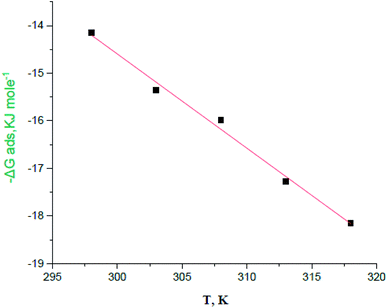 |
| | Fig. 3  plotted against T (K) for H4 derivative. plotted against T (K) for H4 derivative. | |
Table 3 represents the calculated thermodynamic parameters and clarifies that the values of  were negative which indicates that (H4 & H5 & H6) is adsorbed spontaneously. As stated, before by different researches, the type of adsorption was ascribed as physisorption if
were negative which indicates that (H4 & H5 & H6) is adsorbed spontaneously. As stated, before by different researches, the type of adsorption was ascribed as physisorption if  values were −20 kJ mol−1 or lower, the reaction is happened because of the electrostatic attraction between oppositely charged (inhibitor and metal), whereas the values of about −40 kJ mol−1 or more were ascribed as chemisorption because of sharing of the charge or transferring of charge between inhibitor and carbon steel.28–30 The estimated values of
values were −20 kJ mol−1 or lower, the reaction is happened because of the electrostatic attraction between oppositely charged (inhibitor and metal), whereas the values of about −40 kJ mol−1 or more were ascribed as chemisorption because of sharing of the charge or transferring of charge between inhibitor and carbon steel.28–30 The estimated values of  were noticed from −18.55 kJ mol−1 and −14.25 kJ mol−1 that belong to (physical adsorption). The minus values of
were noticed from −18.55 kJ mol−1 and −14.25 kJ mol−1 that belong to (physical adsorption). The minus values of  were related to the adsorption form of inhibitor molecules is an exothermic reaction. Exothermic reaction corresponded to either physisorption or chemisorption but an endothermic reaction is corresponded to as chemisorption.31 Also, enthalpy values are around 41.9 kJ mol−1 which related to physisorption and those up to 100 kJ mol−1 or larger are related to chemisorption. The determined
were related to the adsorption form of inhibitor molecules is an exothermic reaction. Exothermic reaction corresponded to either physisorption or chemisorption but an endothermic reaction is corresponded to as chemisorption.31 Also, enthalpy values are around 41.9 kJ mol−1 which related to physisorption and those up to 100 kJ mol−1 or larger are related to chemisorption. The determined  assessments are negative and ranged from 40.3 to 48.8 kJ mol−1 demonstrating that (H4 & H5 & H6) could be physiosorbed. The
assessments are negative and ranged from 40.3 to 48.8 kJ mol−1 demonstrating that (H4 & H5 & H6) could be physiosorbed. The  calculations are minus that corresponding to the presence of the adsorbed molecules on carbon steel surface. In addition, Fig. 3 shows
calculations are minus that corresponding to the presence of the adsorbed molecules on carbon steel surface. In addition, Fig. 3 shows  against various T (K) for H4 inhibitor.
against various T (K) for H4 inhibitor.
The activation factors for the dissolution procedure were calculated according to Arrhenius eqn (16):
| |
 | (16) |
where
kcorr is the corrosion ratio,
A is the Arrhenius constant,

is the activation energy,
R is the universal gas constant, and
T is the temperature. Estimations of

of carbon steel corrosion in the presence of measured amounts of (H4 & H5 & H6) were obtained from the relation of log
![[thin space (1/6-em)]](https://www.rsc.org/images/entities/char_2009.gif) kcorr
kcorr against 1000/
T graphs as appeared in
Fig. 4, the transition state relation is obtained from
eqn (17):
| | |
kcorr = (RT/Nh)exp(ΔS*/R)exp(−ΔH*/RT)
| (17) |
where
N is the Avogadro's factor,
h is referred to Planck's parameter, Δ
S* is the activated entropy and Δ
H* represents the activated enthalpy. A diagram of log(
kcorr/
T)
versus (1000/
T) give straight lines as shown in
Fig. 5, with slopes is (Δ
H*/2.303
R) and intercepts is log(
R/
Nh) + Δ
S*/2.303
R. All calculations are listed in
Table 4, the increase in

values demonstrated that (H4 & H5 & H6) is physiosorbed on the carbon steel surface.
32 The positive indications of Δ
H* values give the endothermic idea of the carbon steel dissolution procedure. The negative indications of Δ
S* demonstrated that in the rate determine step, the association of unstable coordinated molecules is larger than the dissociation.
24,33
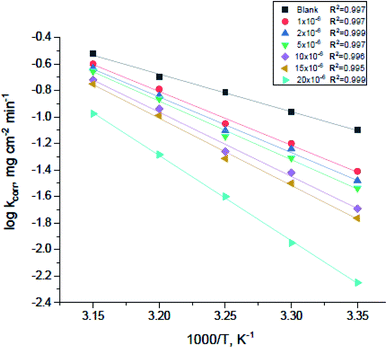 |
| | Fig. 4 Arrhenius plots for carbon steel corrosion rates (kcorr) against 1000/T after 120 minutes of immersion in 1.0 M HCl with and without altered concentrations of compound (H4). | |
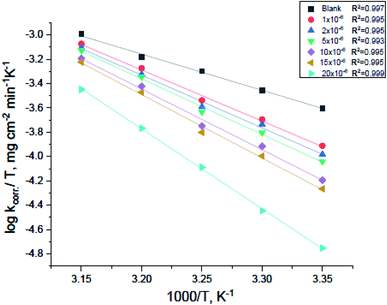 |
| | Fig. 5 Plots of (log![[thin space (1/6-em)]](https://www.rsc.org/images/entities/char_2009.gif) kcorr/T) vs. 1000/T for corrosion of carbon steel in 1.0 M HCl with and without altered concentrations of compound (H4). kcorr/T) vs. 1000/T for corrosion of carbon steel in 1.0 M HCl with and without altered concentrations of compound (H4). | |
Table 4 Activation parameters for the dissolution of carbon steel with and without altered concentrations of derivatives in 1.0 M HCl
| Comp. |
Conc. |
Activation parameters |

|
ΔH* (kJ mol−1) |
−ΔS* (J mol−1 K−1) |
| |
Blank |
55.14 |
57.71 |
73.30 |
| H4 |
1 × 10−6 |
77.74 |
80.29 |
3.51 |
| 2 × 10−6 |
80.47 |
83.03 |
4.46 |
| 5 × 10−6 |
84.73 |
87.28 |
17.48 |
| 10 × 10−6 |
92.90 |
95.45 |
42.00 |
| 15 × 10−6 |
97.17 |
99.71 |
54.79 |
| 20 × 10−6 |
123.16 |
125.69 |
132.54 |
| H5 |
1 × 10−6 |
76.21 |
78.76 |
8.63 |
| 2 × 10−6 |
80.22 |
82.77 |
3.97 |
| 5 × 10−6 |
83.96 |
86.51 |
15.15 |
| 10 × 10−6 |
89.40 |
91.94 |
31.45 |
| 15 × 10−6 |
93.28 |
95.83 |
43.13 |
| 20 × 10−6 |
111.34 |
113.88 |
99.87 |
| H6 |
1 × 10−6 |
77.74 |
80.29 |
3.51 |
| 2 × 10−6 |
80.86 |
83.41 |
5.74 |
| 5 × 10−6 |
84.73 |
87.28 |
17.48 |
| 10 × 10−6 |
93.67 |
96.21 |
44.42 |
| 15 × 10−6 |
97.17 |
99.71 |
54.79 |
| 20 × 10−6 |
126.94 |
129.46 |
144.61 |
3.1.2 Effect of temperature. The influence of temperature on the corrosion rates of carbon steel in 1 M HCl and in the presence of gradual inhibitor amounts was considered in the temperature from 30 to 45 °C using the weight loss method. As the temperature rises, the % IE of the added inhibitors slightly increases which is the characteristics of chemisorption, the results were summarized in Table 5.
Table 5 Weight loss results for carbon steel sheets in 1 M HCl solution without and with gradual concentrations of (H4 & H5 & H6) at 30–45 °C
| Comp. |
Temp. |
30 °C |
35 °C |
40 °C |
45 °C |
| Conc. |
θ |
% IE |
θ |
% IE |
θ |
% IE |
θ |
% IE |
| H4 |
1 × 10−6 |
0.537 |
53.7 |
0.566 |
56.6 |
0.562 |
56.2 |
0.583 |
58.3 |
| 2 × 10−6 |
0.588 |
58.8 |
0.599 |
59.9 |
0.605 |
60.5 |
0.621 |
62.1 |
| 5 × 10−6 |
0.682 |
68.2 |
0.697 |
69.7 |
0.701 |
70.1 |
0.787 |
78.7 |
| 10 × 10−6 |
0.783 |
78.3 |
0.802 |
80.2 |
0.821 |
82.1 |
0.838 |
83.8 |
| 15 × 10−6 |
0.826 |
82.6 |
0.831 |
83.1 |
0.852 |
85.2 |
0.865 |
86.5 |
| 20 × 10−6 |
0.909 |
90.9 |
0.924 |
92.4 |
0.945 |
94.5 |
0.962 |
96.2 |
| H5 |
1 × 10−6 |
0.381 |
38.1 |
0.425 |
42.5 |
0.444 |
44.4 |
0.484 |
48.4 |
| 2 × 10−6 |
0.522 |
52.2 |
0.548 |
54.8 |
0.587 |
58.7 |
0.596 |
59.6 |
| 5 × 10−6 |
0.587 |
58.7 |
0.607 |
60.7 |
0.618 |
61.8 |
0.623 |
62.3 |
| 10 × 10−6 |
0.695 |
69.5 |
0.729 |
72.9 |
0.744 |
74.4 |
0.751 |
75.1 |
| 15 × 10−6 |
0.711 |
71.1 |
0.735 |
73.5 |
0.766 |
76.6 |
0.782 |
78.2 |
| 20 × 10−6 |
0.883 |
88.3 |
0.906 |
90.6 |
0.929 |
92.9 |
0.926 |
92.6 |
| H6 |
1 × 10−6 |
0.412 |
41.2 |
0.452 |
45.2 |
0.454 |
45.4 |
0.464 |
46.4 |
| 2 × 10−6 |
0.501 |
50.1 |
0.521 |
52.1 |
0.522 |
52.2 |
0.582 |
58.2 |
| 5 × 10−6 |
0.574 |
57.4 |
0.623 |
62.3 |
0.685 |
68.5 |
0.691 |
69.1 |
| 10 × 10−6 |
0.643 |
64.3 |
0.645 |
64.5 |
0.663 |
66.3 |
0.685 |
68.5 |
| 15 × 10−6 |
0.802 |
80.2 |
0.824 |
82.4 |
0.825 |
82.5 |
0.844 |
84.4 |
| 20 × 10−6 |
0.955 |
95.5 |
0.953 |
95.3 |
0.952 |
95.2 |
0.965 |
96.5 |
3. 2Potentiodynamic polarization (PDP) method
The polarization curves for carbon steel in corrosive media having increasing amounts of (H4 & H5 & H6) at 25 °C are illustrated in Fig. 6. kinetic parameters as corrosion current (Icorr), corrosion potential (Ecorr), and Tafel slopes (βa and βc) were got from the obtained figures and are shown in Table 6 for carbon steel in 1 M HCl corrosive medium with and without gradual concentrations of (H4 & H5 & H6). % IE rises with increasing the concentrations of the compounds. Fig. 6 shows that the Icorr values decrease by the addition of the additives which decreases the carbon steel oxidation. The increase of the concentration of the compounds influences the anodic and cathodic directions of the polarization curves. The increase in the concentrations of additives moved the Ecorr values towards the negative values when comparing with the blank. Hence, addition of (H4 & H5 & H6) decrease the carbon steel corrosion and suppress hydrogen release as demonstrated of equal cathodic Tafel curves in Fig. 6. The parallel lines of the Tafel lines after the addition of the (H4 & H5 & H6) indicate that there is no change in the mechanism of both H2 release and metal consumption processes. In fact, the inhibitor is categorized as cathodic or anodic kind if the moving of corrosion potential in the existence of the inhibitor is ±85 mV from that in the absence of the inhibitor. (H4 & H5 & H6) presence shifts Ecorr values to values not exceeded 15 mV, and Tafel slopes of βa and βc at 25 °C did not notably changed which indicated that (H4 & H5 & H6) can be categorized as a mixed-type inhibitors.34
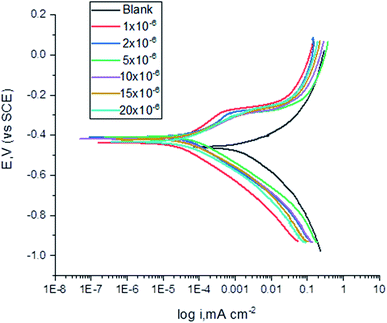 |
| | Fig. 6 Potentiodynamic polarization curves for the corrosion of carbon steel in 1.0 M HCl in the absence and presence of altered concentrations of compound (H4) at 25 °C. | |
Table 6 The effect of concentration of (H4 & H5 & H6) on the corrosion potential (Ecorr), corrosion current (Icorr), Tafel slopes (βa & βc), corrosion rate (C.R.), surface coverage (θ) and inhibition efficacy (% IE) for the corrosion of carbon steel 1 M HCl at 25 °Ca
| C. |
Conc. |
Icorr, μA cm−2 |
−Ecorr, mV (vs. SCE) |
βa, mV dec−1 |
βc, mV dec−1 |
C.R. (mpy) |
θ |
% IE |
| Where mpy mean Mils per year (1 Mil = 0.025 mm). |
| |
Blank |
216 ± 2.6457 |
413 ± 2.3094 |
101.6 ± 2.0275 |
155.7 ± 2.3184 |
98.77 ± 2.333 |
— |
— |
| H4 |
1 × 10−6 |
158 ± 2.3331 |
406 ± 2.1245 |
95.5 ± 2.3312 |
165.5 ± 1.7202 |
72.40 ± 1.1821 |
0.27 |
26.85 |
| 2 × 10−6 |
130 ± 2.1042 |
405 ± 2.4523 |
85.6 ± 2.31523 |
153.6 ± 2.1555 |
59.62 ± 2.3281 |
0.40 |
39.81 |
| 5 × 10−6 |
57.4 ± 2.2154 |
406 ± 2.1458 |
74.8 ± 2.1423 |
152.7 ± 2.2631 |
22.48 ± 2.1934 |
0.73 |
73.43 |
| 10 × 10−6 |
49.2 ± 2.1254 |
409 ± 2.0365 |
71.5 ± 2.1126 |
142.6 ± 2.2236 |
14.60 ± 2.00771 |
0.77 |
77.22 |
| 15 × 10−6 |
37.9 ± 2.0298 |
415 ± 2.1174 |
87.9 ± 2.0935 |
146.4 ± 2.1142 |
26.23 ± 2.1783 |
0.82 |
82.45 |
| 20 × 10−6 |
31.9 ± 2.1278 |
431 ± 2.0032 |
94.7 ± 2.0364 |
152.2 ± 2.2513 |
17.33 ± 2.4190 |
0.85 |
85.23 |
| H5 |
1 × 10−6 |
128 ± 2.30125 |
425 ± 2.4312 |
95.4 ± 2.0031 |
156.1 ± 2.1423 |
58.44 ± 2.2587 |
0.41 |
40.74 |
| 2 × 10−6 |
94.4 ± 2.4251 |
425 ± 2.1865 |
94.9 ± 2.3251 |
151.7 ± 2.1236 |
43.12 ± 2.1679 |
0.56 |
56.30 |
| 5 × 10−6 |
81.5 ± 2.1798 |
433 ± 2.1634 |
102.1 ± 2.3006 |
159.3 ± 2.6342 |
37.26 ± 2.1376 |
0.62 |
62.27 |
| 10 × 10−6 |
46.5 ± 2.0952 |
434 ± 2.0021 |
86.7 ± 2.0202 |
145.3 ± 2.0973 |
19.37 ± 1.1665 |
0.78 |
78.47 |
| 15 × 10−6 |
43.2 ± 2.01151 |
435 ± 2.1852 |
93.8 ± 2.0731 |
149.5 ± 2.1637 |
21.24 ± 2.3411 |
0.80 |
80.00 |
| 20 × 10−6 |
42.4 ± 2.1123 |
430 ± 2.3126 |
111.9 ± 2.1142 |
163.5 ± 2.18341 |
19.72 ± 2.3673 |
0.80 |
80.37 |
| H6 |
1 × 10−6 |
152 ± 2.3147 |
406 ± 2.4513 |
91.8 ± 2.1236 |
162.5 ± 2.0088 |
69.29 ± 2.31165 |
0.30 |
23.02 |
| 2 × 10−6 |
115 ± 2.0254 |
405 ± 2.0265 |
77.1 ± 2.1140 |
144.9 ± 2.1236 |
52.42 ± 2.3001 |
0.47 |
46.8 |
| 5 × 10−6 |
44.1 ± 2.1423 |
406 ± 2.1234 |
70.1 ± 2.7521 |
146.3 ± 2.4352 |
20.16 ± 1.1821 |
0.80 |
79.15 |
| 10 × 10−6 |
43.7 ± 1.7451 |
409 ± 2.01472 |
73.4 ± 2.1361 |
145.9 ± 2.1958 |
15.39 ± 2.1281 |
0.80 |
79.99 |
| 15 × 10−6 |
33.7 ± 2.0025 |
408 ± 2.01321 |
79.9 ± 2.0631 |
155.9 ± 2.30167 |
19.95 ± 2.0131 |
0.84 |
84.62 |
| 20 × 10−6 |
26.1 ± 2.1436 |
400 ± 2.12368 |
81.8 ± 2.3421 |
151.2 ± 2.4219 |
11.95 ± 2.0731 |
0.88 |
88.01 |
3.3 (EIS) measurements
The corrosion of carbon steel in 1 M HCl medium with and without various concentrations of (H4 & H5 & H6) was researched by EIS technique at 25 °C after 30 min. of immersion. Fig. 7 shows circuit model used to carry out EIS experiment and Fig. 8 shows the Nyquist plot for carbon steel in 1 M HCl medium in the absence and presence of various amounts of (H4 & H5 & H6). The way that impedance charts have as semi-round appearance clarifies that the oxidation of carbon steel in 1 M HCl is faced by a charge transfer impedance process.35 The semi-circle is observed in EIS measurements and the diameter of semicircle is increased by increasing (H4, H5 and H6) concentrations. This is attributed to the occurrence of low charge transfer in the solution.36 The charge transfer resistance Rct at active carbon steel/electrolyte interface is increased by increasing (H4, H5 and H6) concentrations confirmed by the increase in radius of the semicircle. The increase in resistance value predicted the decrease in electronic conduction which results into low-kinetic reaction.37 Fig. 9 shows The Bode plot for carbon steel in 1 M HCl at gradual concentrations of (H4) at 25 °C which shows the same behavior. The circuit appeared in Fig. 7 was applied to calculate (RP) from eqn (18):| | |
RP = (Rct × RL)/(Rct + RL)
| (18) |
where (L), is the inductance, RL is the inductive resistance.38
 |
| | Fig. 7 Circuit used to investigate EIS. | |
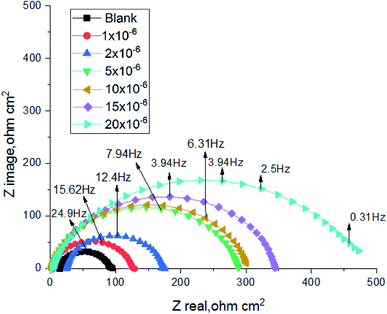 |
| | Fig. 8 The Nyquist plots for corrosion of C-steel in 1.0 M HCl in the absence and presence of different concentrations of compound (H4) at 25 °C. | |
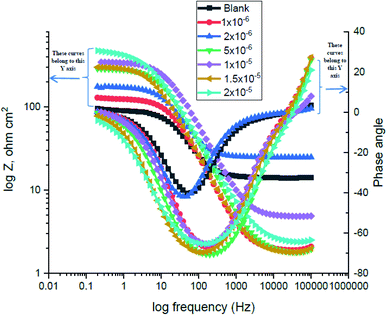 |
| | Fig. 9 The Bode plots for C-steel in 1 M HCl at different concentrations of inhibitor (H4) at 25 °C. | |
EIS information from Table 7 illustrates that, the RP values raised (due to increase in the thickness of double layer) and the Cdl values decreased with the increase of (H4 & H5 & H6) amounts, which is most probably due to the decrease in local dielectric constant and/or increase in the thickness of the electric double layer. This suggests that these derivatives act through adsorption of inhibitor molecules on the metal/acid interface.38 This is because of the continuous substitution of (H4 & H5 & H6) molecules by H2O molecules adsorbed on the carbon steel surface and decreasing the degree of the dissolution reaction. The large RP values are referred to a small corrosion procedure.39 Cdl is lowered with increasing concentration because of the decrease of the dielectric constant or may be due to the enlargement double layer,40 which assure that the adsorption of (H4 & H5 & H6) mitigates carbon steel corrosion for a large extent.
Table 7 Electrochemical kinetic parameters obtained by EIS technique for in 1 M HCl without and with various concentrations of investigated compounds at 25 °C
| C. |
Conc. |
Rp, Ω cm2 |
Cdl, μF cm−2 |
θ |
% IE |
| |
Blank |
77.7 |
105.25 ± 1.731 |
— |
— |
| H4 |
1 × 10−6 |
123.2 |
85.05 ± 2.1254 |
0.369 |
36.92 |
| 2 × 10−6 |
148.2 |
79.47 ± 2.0215 |
0.476 |
47.56 |
| 5 × 10−6 |
286.8 |
72.30 ± 2.0924 |
0.729 |
72.90 |
| 10 × 10−6 |
298.9 |
54.40 ± 2.2364 |
0.740 |
74.00 |
| 15 × 10−6 |
338.5 |
42.99 ± 2.423 |
0.770 |
77.04 |
| 20 × 10−6 |
461.8 |
40.50 ± 2.0612 |
0.832 |
83.17 |
| H5 |
1 × 10−6 |
147 |
94.88 ± 2.1423 |
0.471 |
47.13 |
| 2 × 10−6 |
164.5 |
89.95 ± 2.1932 |
0.528 |
52.75 |
| 5 × 10−6 |
215.7 |
76.53 ± 2.12764 |
0.640 |
63.97 |
| 10 × 10−6 |
393.4 |
63.60 ± 2.1135 |
0.802 |
80.24 |
| 15 × 10−6 |
411.7 |
58.20 ± 2.16349 |
0.811 |
81.12 |
| 20 × 10−6 |
545.9 |
42.00 ± 2.2218 |
0.858 |
85.76 |
| H6 |
1 × 10−6 |
123.2 |
79.51 ± 2.3160 |
0.321 |
36.94 |
| 2 × 10−6 |
148.3 |
72.78 ± 2.1147 |
0.495 |
47.32 |
| 5 × 10−6 |
286.4 |
56.77 ± 2.0077 |
0.751 |
72.15 |
| 10 × 10−6 |
317.8 |
51.46 ± 2.16831 |
0.762 |
75.25 |
| 15 × 10−6 |
338.4 |
48.81 ± 2.1734 |
0.784 |
77.01 |
| 20 × 10−6 |
653.7 |
43.33 ± 2.1635 |
0.891 |
88.45 |
3.4 Atomic force microscope (AFM) examination
AFM gives microscopic photos for carbon steel surface topography perfectly, which assess the roughness of the examined metal. The 3D AFM morphologies for pure carbon steel outer surface and carbon steel in 1 M HCl in the absence and existence of (H4 & H5 & H6) for 24 hours have appeared in Fig. 10. The photograph of carbon steel outer surface in 1 M HCl has a larger roughness (993.8 nm) than the free carbon steel sample (17.5 nm), which clarifies that the carbon steel blank sample is severely corroded because of the corrosive attacks. The obtained roughness of inhibited carbon steel as shown in Table 8 and Fig. 10 was reduced to low values (160.3 nm in H4, 279.9 nm in H5 & 134.2 nm in H6) because of the effectiveness of the adsorbed layer of inhibitors on the outer surface, hence impeding the corrosion of carbon steel.41
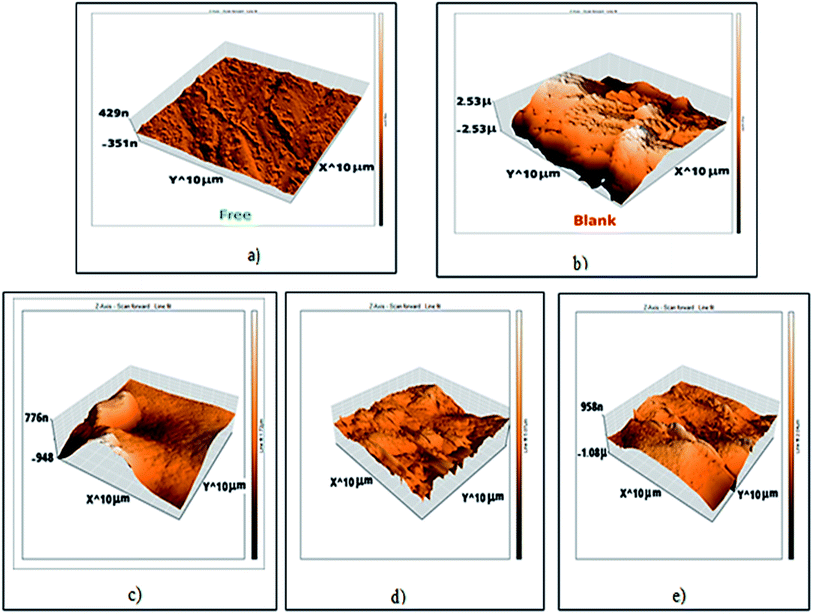 |
| | Fig. 10 AFM 3d photos of: (a) carbon steel free surface, (b) carbon steel in 1 M HCl only, (c) carbon steel in 1 M HCl + 20 × 10−6 M of H4, (d) carbon steel in 1 M HCl + 20 × 10−6 M of H5, (e) carbon steel in 1 M HCl + 20 × 10−6 M of H6 (after 24 hours of immersion). | |
Table 8 Roughness of all samples that appeared through atomic force microscope (AFM) examinations
| Sample |
Roughness (nm) |
| Free |
17.5 |
| Blank |
993.8 |
| H4 |
160.34 |
| H5 |
279.9 |
| H6 |
134.2 |
3.5 FT-IR spectroscopy analysis
FT-IR spectroscopy shows the functional groups of the solutions and its behavior on the metal surface after adsorption, with high precision.42 From Fig. 11–13 which concern (H4) inhibitor, the FTIR charts could be interpreted as illustrated in Table 9. Fig. 11–13 illustrate FT-IR spectra of pure inhibitors liquid and the layer formed on carbon steel samples after putting in 1.0 M HCl for a day in the presence of 20 × 10−6 M of (H4) when comparing the spectra of inhibitor solution with the spectra of the carbon steel surface after immersion, the two spectra have the same properties, which mean that the compounds were adsorbed on the carbon steel surface.18 The obtained results illustrate the mechanism of interference between (H4 & H5 & H6) and carbon steel surface. The shifting and missing in the spectra after immersion showed that the interaction between (H4 & H5 & H6) and carbon steel surface was happened through functional groups mentioned in Table 9.
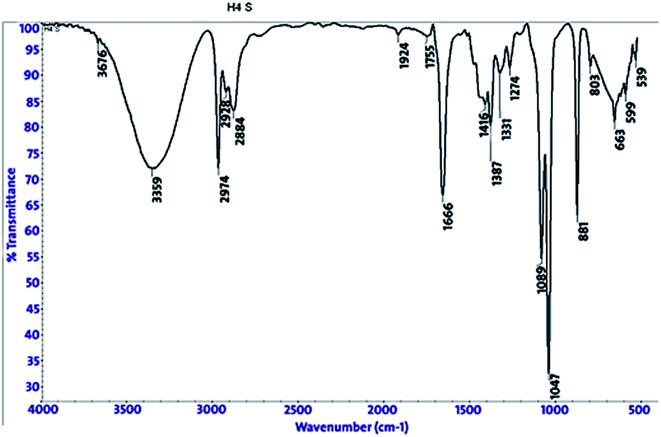 |
| | Fig. 11 IR spectra of 20 × 10−6 M of compound (H4) solution at 25 °C. | |
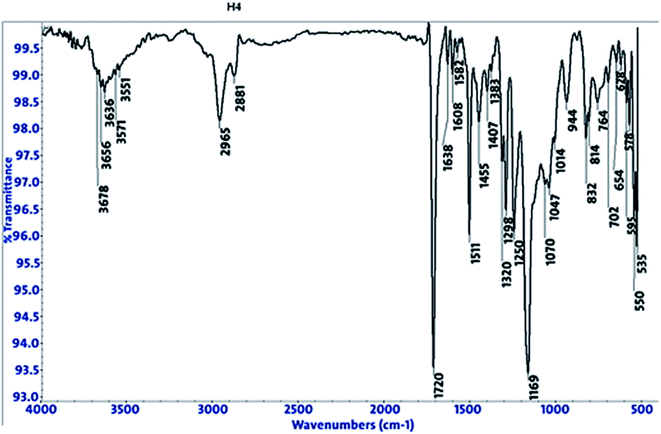 |
| | Fig. 12 IR spectra of carbon steel surface after 3 hours immersion in 20 × 10−6 M of compound (H4) at 25 °C. | |
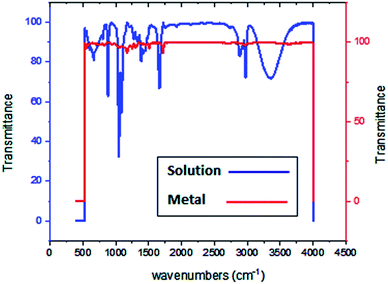 |
| | Fig. 13 Combined IR chart of pure solution and carbon steel surface after 3 hours immersion in 20 × 10−6 M of compound (H4) at 25 °C. | |
Table 9 IR spectra of (H4 & H5 & H6) pure solutions and the spectra of the metal surface after inhibitors adsorption
| Compound |
Pure solution beaks & frequencies (cm−1) |
Frequencies refer to |
Shifting and missing of beaks & frequencies (cm−1) after adsorption |
| H4 |
3359 |
OH, N–H stretching |
3636 |
| 2974, 2928 and 2884 |
(CH3) and (C–H) extending |
One beak at 2965 |
| 1666 |
(C![[double bond, length as m-dash]](https://www.rsc.org/images/entities/char_e001.gif) 0) attached to NH 0) attached to NH |
1720 |
| 1047 |
(C–O) stretch |
1169 |
| 1387 |
(C–H) |
1511 |
| 881 |
(![[double bond, length as m-dash]](https://www.rsc.org/images/entities/char_e001.gif) CH2, CH2, ![[double bond, length as m-dash]](https://www.rsc.org/images/entities/char_e001.gif) C–H) C–H) |
832 |
| H5 |
3349 |
OH, N–H stretching |
Missed |
| 2974, 2928 and 2883 |
(CH3) and (C–H) extending |
(3037, 2969, 2882) |
| 1668 |
(C![[double bond, length as m-dash]](https://www.rsc.org/images/entities/char_e001.gif) 0) attached to NH 0) attached to NH |
1720 |
| 1047 |
(C–O) stretch |
1169 |
| 1386 |
(C–H) |
1298 |
| 881 |
(![[double bond, length as m-dash]](https://www.rsc.org/images/entities/char_e001.gif) CH2, CH2, ![[double bond, length as m-dash]](https://www.rsc.org/images/entities/char_e001.gif) C–H) C–H) |
831 |
| H6 |
3344 |
OH, N–H stretching |
Missed |
| (2974, 2928 and 2883) |
(CH3) and (C–H) extending |
(3036, 2965, 2876) |
| 1668 |
(C![[double bond, length as m-dash]](https://www.rsc.org/images/entities/char_e001.gif) 0) attached to NH 0) attached to NH |
1720 |
| 1047 |
(C–O) stretch |
1169 |
| 1385 |
(C–H) holding |
1320 |
| 881 |
(![[double bond, length as m-dash]](https://www.rsc.org/images/entities/char_e001.gif) CH2, CH2, ![[double bond, length as m-dash]](https://www.rsc.org/images/entities/char_e001.gif) C–H) C–H) |
831 |
3.6 X-ray photoelectron spectroscopy (XPS) examination
It is a perfect system that can predict the adsorbed atoms on the metal surface. The XPS examination of H4 was mainly prospected for definite atoms such as (C, O, N and Fe), the obtained results are shown in Fig. 14 for carbon steel after immersion in 1 M HCl with 20 × 10−6 M of (H4) at 25 °C for 24 hours. Analysis of the obtained data43,44 for the three inhibitors were summarized in Table 10.
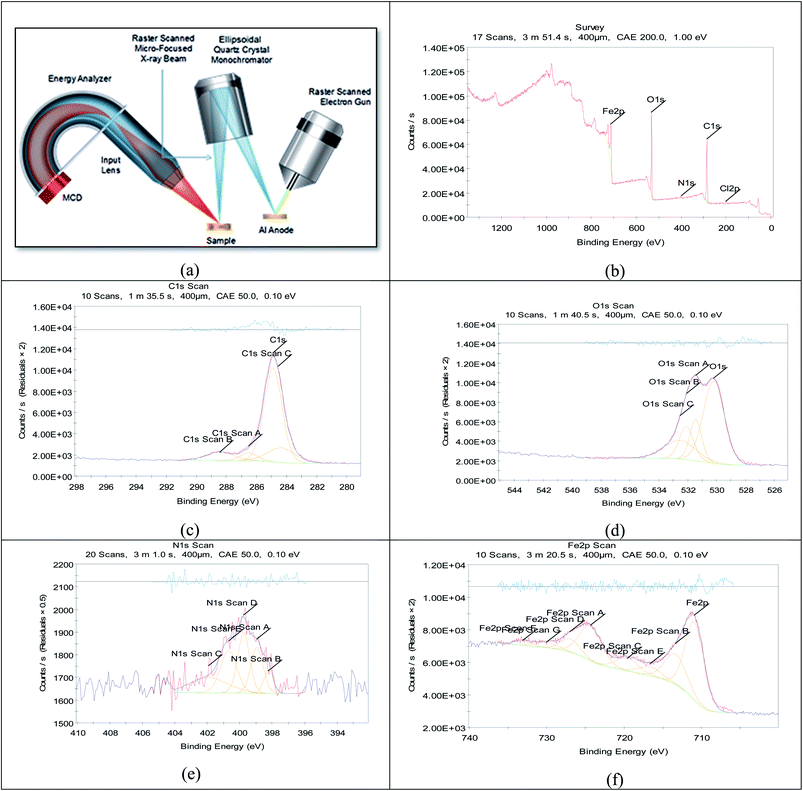 |
| | Fig. 14 XPS graphs of (a) XPS device, (b) general survey, (c) C 1s scan (d) O 1s scan (e) N 1s scan (f) Fe 2p scan of carbon steel after immersion in 1 M HCl + 20 × 10−6 M of (H4) inhibitor for 24 h. | |
Table 10 Binding energies of different surveys and its expected bonds
| C. |
Scan type |
Binding energies peaks (eV) |
Peak refers to |
| H4 |
C 1s |
284.5 |
C–C |
| 287.1 |
–C![[double bond, length as m-dash]](https://www.rsc.org/images/entities/char_e001.gif) O O |
| 285 |
C–N |
| O 1s |
530.1 |
O2− (Fe2O3 mainly) |
| 531.5 |
OH− of FeOOH |
| 532.45 |
O2 of adsorbed Water. |
| N 1s |
398.2 |
N–Fe |
| 403 |
Protonated nitrogen atoms of hydrazine group |
| Fe 2p |
712.8 |
FeCl3 |
| 710.6 |
Fe2O3/Fe3O4/FeOOH |
| 720 |
Ferric compounds satellites |
| H5 |
C 1s |
284 |
C–C |
| 288.5 |
–C![[double bond, length as m-dash]](https://www.rsc.org/images/entities/char_e001.gif) O O |
| 286.4 |
C–N |
| O 1s |
530.1 |
O2− (Fe2O3 mainly) |
| 531.88 |
OH− of FeOOH |
| 532.5 |
O2 of adsorbed water |
| N 1s |
398.2 |
N–Fe |
401![[thin space (1/6-em)]](https://www.rsc.org/images/entities/char_2009.gif) |
Protonated nitrogen atoms of hydrazine group |
| Fe 2p |
720 |
Ferric compounds satellites |
| 710 |
Fe2O3/Fe3O4/FeOOH |
| 713 |
FeCl3 |
| H6 |
C 1s |
284.9 |
C–C |
| 288.2 |
–C![[double bond, length as m-dash]](https://www.rsc.org/images/entities/char_e001.gif) O O |
| 286.7 |
C–N |
| O 1s |
529.8 |
O2− (Fe2O3 mainly) |
| 531.1 |
OH− of FeOOH |
| 533 |
O2 of adsorbed water |
| N 1s |
399 |
N–Fe |
| 403.3 |
Protonated nitrogen atoms of hydrazine group |
| Fe 2p |
706.2 |
Fe0 |
| 710.1 |
Fe2O3/Fe3O4/FeOOH |
| 713.2 |
FeCl3 |
| 720 |
Ferric compounds satellites |
XPS technique was used to investigate the composition of the organic adsorbed layer on the carbon steel surface in normal hydrochloric medium by investigated inhibitors. In this way, the high-resolution peaks for C 1s, O 1s, N 1s and Fe 2p for carbon steel surface after 24 h of immersion in 1 M HCl solution containing 20 × 10−6 M of inhibitor could be measured. All XPS spectra contained complex forms, which were assigned to the corresponding species through a deconvolution fitting procedure (a non-linear least squares algorithm with a Shirley base line and a Gaussian–Lorentzian combination). All mentioned groups and bonds are found in the investigated inhibitors, so the experiment elucidated the adsorption of the investigated inhibitors on the metal surface. To illustrate data that collected in Table 10 we will take an example of Fe 2p3/2 of inhibitor H6. The deconvolution of the high-resolution Fe 2p3/2 XPS spectrum divided to four peaks. These peaks referred to iron in environments associated with iron oxide and hydroxide. Indeed, the first peak located at 706.2 was assigned to metallic iron (Fe0). The second peak at a BE ∼710.1 eV assigned to Fe3+ was attributed to ferric compounds such as Fe2O3 (i.e., Fe3+ oxide) and/or Fe3O4 (i.e., Fe2+/Fe3+ mixed oxide) and FeOOH (i.e., oxyhydroxide), while that located at around 713.2 eV is attributed to the presence of a small concentration of FeCl3 on the metal surface. The last peak, observed at 720 eV is probably ascribed to the satellites of the ferric compounds.45
3.7 Quantum chemical calculations
Theoretical chemistry has been used frequently to interpret the corrosion inhibition mechanism; quantum chemical calculations are the most common approach. This approach has been clarified as a very excellent system for researching the interaction mechanism. To assess their efficiency as corrosion inhibitors for carbon steel in HCl solution, quantum chemical calculations based on the density-functional theory (DFT) technique were conducted on the three investigated heterocyclic compounds. Matter of fact, an inhibitor's efficiency depends on its molecular structure. Frontier orbital theory is used to predict the adsorption centers of the inhibitor molecules which interact with Fe atoms. As reported, effective corrosion inhibitors are those which donates electrons to an empty orbital of the metal and at the same time receive electrons from the metal surface.46 Frontier orbital theory stated that, any chemical reaction mainly happened between HOMO (highest occupied molecular orbital) of one reactant and LUMO (lowest unoccupied molecular orbital) of the other reactant, the interaction between these orbitals constitutes the adsorption mechanism. Hence, it is essential to assess the presence of HOMO and LUMO orbitals of the investigated compounds to interpret the inhibition mechanism. Inhibitors with a high energy level of HOMO can give electrons to the unoccupied orbitals of acceptor. EHOMO corresponds to the molecule's capacity to donate electrons, and ELUMO corresponds to the molecule's capacity to accept electrons. Table 11 illustrates the geometrical structure of three inhibitors with specific distribution sites for HOMO and LUMO. A molecule of the inhibitor was spread around the surface of carbon metal. This method of distribution guarantees the adsorption of the inhibitor on the metal surface in two ways: one is that the inhibitor molecules send electrons to unoccupied (d) orbitals of Fe atom to form a coordinate bond, the other is that Fe atom electrons are received by the inhibitor molecule, which forms a back-bond between the metal surface and the inhibitor. It was previously known that low values of ΔE give excellent inhibition efficiency; because the energy needed for separating an electron from the highest occupied molecular orbital (HOMO) is low. Table 11 shows the values of ΔE that was increased in the following order: (H5 > H4 > H6), which means that the adsorption efficiency can be arranged in the following order H6 > H4 > H5. The findings of quantum chemical calculations in this study were in harmony with the experimental results. The investigated compounds were different in adsorption ability that could be explained according to Gece and Bilgiç,47 they stated that when the sites of N, O atoms was changed in their sites in the compound structure, the corrosion inhibition efficiency is consequently changed, which explains the difference in the obtained efficiencies between the three inhibitors. The electron configuration of Fe is [Ar]4s23d6; the 3d orbitals are not fully occupied with electrons. N atom with electron configuration [He]2s22p3 and O atom with electron configuration, [He]2s22p4, has lonely electron pairs that are highly needed by Fe for completing unfilled 3d orbitals so, it adsorbed inhibitor molecules on the metal surface.48 As shown in Fig. 15, the electron density concentrated on N atoms. The sites of highest electron density are in fact the sites which electrophiles attacked. Hence, N and O atoms are the active center, which has the best ability of binding with the Fe surface. Many reactivity parameters were evaluated to assure the effectiveness of hydrazide derivatives as corrosion inhibitors. These include softness σ(S), electronegativity (v), chemical hardness (η), ΔN, and Δw. All quantum parameters were shown in Table 11. And the optimized geometries HOMO and LUMO distribution of (H4 & H5 & H6) in their non-protonated form are shown in Fig. 15, the reference of orbitals colors that shown in Fig. 15 was illustrated in Table 12.
Table 11 Quantum calculation parameters: highest occupied molecular orbital energy (EHOMO), lowest unoccupied molecular orbital energy (ELUMO), the energy gap (ΔE), global hardness (η), softness (σ), electronegativity (χ), global electrophilicity (ω), ΔN, and Δw
| Code |
H4 |
H5 |
H6 |
| Program |
MS-Dmol6 |
MS-Dmol6 |
MS-Dmol6 |
| Method |
DFT |
DFT |
DFT |
| Basis set |
DNP (4.4) |
DNP (4.4) |
DNP (4.4) |
| Function |
GGA-RPBE |
GGA-RPBE |
GGA-RPBE |
| EHOMO (eV) |
−5.24731 |
−5.13616 |
−4.56568 |
| ELUMO (eV) |
−3.29443 |
−2.96602 |
−3.16616 |
| ΔE = ELUMO − EHOMO |
1.95288 |
2.17013 |
1.39953 |
| η = ΔE/2 |
0.97644 |
1.08507 |
0.69976 |
| σ(S) = 1/η |
1.02413 |
0.92160 |
1.42905 |
| Pi = (EHOMO + ELUMO)/2 |
−4.27087 |
−4.05109 |
−3.86592 |
| X = −Pi |
4.27087 |
4.05109 |
3.86592 |
| ΔNmax |
2.18695 |
1.86674 |
2.76230 |
| ΔN (FET) |
0.28119 |
0.35432 |
0.68172 |
| ω |
9.34019 |
7.56235 |
10.67884 |
| ε |
0.10706 |
0.13223 |
0.09364 |
| ΔE back-donation |
−0.24411 |
−0.27127 |
−0.17494 |
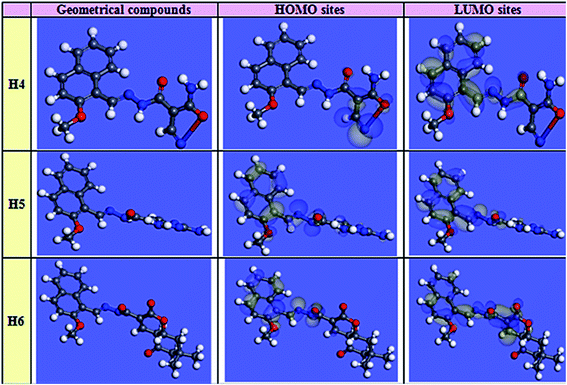 |
| | Fig. 15 Images of HOMO, LUMO electron density and optimized geometry configuration for inhibitor molecules resulted from computational chemical calculations. | |
Table 12 Orbital colors interpretation
| Orbital type |
Color |
Refer to |
| Molecular orbital |
Red/Blue |
Filled orbitals |
| Yellow |
Unfilled orbitals |
| Electrostatic potential |
Red |
Negative sites |
| Blue |
Positive sites |
| Electrophilic (HOMO) |
Blue |
Site most susceptible to attack by a electrophile |
| Nucleophilic (LUMO) |
Blue |
Site most susceptible to attack by a nucleophile |
3.8 Molecular simulation results
The computational Monte Carlo (MC) method was performed to study the adsorption behavior of (H4 & H5 & H6) on the carbon steel surface in the solution presence of H3O+, Cl− and H2O molecules. Side and top views of the adsorbed (H4 & H5 & H6) molecules on Fe surface are shown in Fig. 16. Computer simulations were achieved to understand how the inhibitors react with the carbon steel surface and how the geometrical structures of inhibitors molecules are arranged in Fe surface, the figure shows the protonated form of the inhibitor in solution. All inhibitor molecules arranged in superficial orientation on the Fe surface, which aids to form ideal coverage of the carbon steel surface. Adsorption could be understood as sending and receiving electrons at the HOMO and LUMO locations, which create coordination and back donation bonds, and electrostatic interaction can be represented as the other adsorbed sites on the Fe surface. The findings in Tables 13 and 14 give the calculated energies in vacuum and acid solution, respectively, such as total energy, adsorption energy, rigid absorption energy, and deformation energies. The (H4 & H5 & H6) inhibitor molecules are adsorbed in flat mode on the clean surface of Fe, allowing perfect interactions of N & O atoms and π-electrons with the surface of carbon steel. In addition, the inhibitor molecules detach H2O molecules from their adsorption sites and take their place, meaning that more inhibitors will displace H2O molecules by increasing the inhibitor molecules in the solution.49 The adsorption energy is, in fact, equal to the sum of the rigid energy of adsorption and the energy of deformation which is used to describe the adsorption of molecules on the metal surface. When the inhibitor molecules are adsorbed on the surface of Fe, the energy generated or adsorbed is called the rigid energy of adsorption. In all simulations, negative values of adsorption energy refer to a strong binding of (H4 & H5 & H6) on the Fe surface.50 This is because of the atoms (N and O), where the bonds of coordination can take place by granting the unoccupied iron orbital their unpaired electrons and a conjugated π-electron. The findings show that the negative adsorption energy values of inhibitors on the surface of carbon steel are in the following order: (H5 > H4 > H6), which means that the strong adsorption arrangement may be described as H6 > H4 > H5. This order is in line with the three inhibitors' practical % IE. The wet simulation (HCl) adsorption energy is greater than the medium of H3O and the medium of H2O. This indicates that the adsorption is enhanced by the involvement of water with the species Cl−.
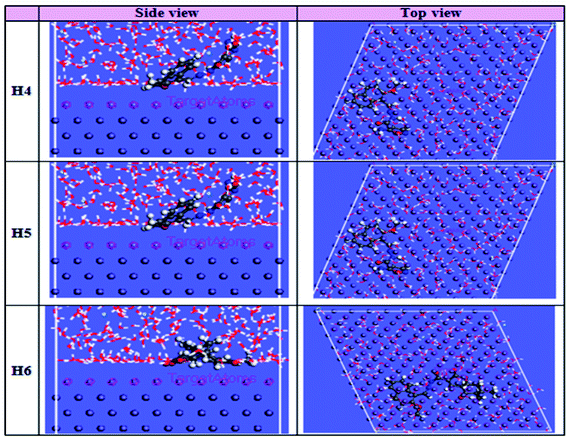 |
| | Fig. 16 Top and side perspectives of the most stable structure of studied samples on the metal surface under acid solution conditions for MC simulations. | |
Table 13 Simulation results (total energy, adsorption energy, rigid absorption energy, and deformation energies) in vacuum
| Structures |
CS–H4 |
CS–H5 |
CS–H6 |
| Total energy |
−244.21576 |
−267.4052 |
−246.99164 |
| Adsorption energy |
−321.14876 |
−291.1181 |
−323.92464 |
| Rigid adsorption energy |
−229.01 |
−196.66 |
−232.17 |
| Deformation energy |
−92.14 |
−94.46 |
−91.75 |
| Inh: dEad/dNi |
−321.15 |
−291.12 |
−323.92 |
Table 14 Simulation results (total energy, adsorption energy, rigid absorption energy, and deformation energies) in acid solutions
| Structures |
CS–H4 |
CS–H5 |
CS–H6 |
| Total energy |
−4019.83 |
−4002.17 |
−4028.35 |
| Adsorption energy |
−4096.76 |
−4025.88 |
−4105.29 |
| Rigid adsorption energy |
−4183.44 |
−4107.05 |
−4184.89 |
| Deformation energy |
86.68 |
81.17 |
79.60 |
| INH: dEad/dNi |
−323.65 |
−212.26 |
−340.60 |
| H2O: dEad/dNi |
−8.73 |
−7.60 |
−11.69 |
| H3O+: dEad/dNi |
−151.74 |
−154.70 |
−147.92 |
| Cl−: dEad/dNi |
−144.41 |
−155.94 |
−152.37 |
3.9 Inhibitive mechanism
Corrosion happens by two essential reactions, oxidation reaction and reduction of hydrogen. Most possibly, the organic molecules present in the compounds prevent corrosion by reducing both reactions. The mechanism of inhibition of the examined inhibitors cannot be considered as only chemical or physical adsorption because Tafel polarization results demonstrate that (H4 & H5 & H6) appears as mixed type inhibitor. The inhibitive mechanism can be explained with two interpretations; the first is chemisorption which happened when some electron donating groups (EDG) that found in (H4 & H5 & H6) inhibitors give their electrons to the unoccupied orbitals found in carbon steel surface. there are many donating atoms and groups found in (H4 & H5 & H6) with lone pairs to give, such as, O–, OH−, NH−, NR, OCH3, alkyl group (CH3), and a conjugated π-electron. These atoms and functional groups can cover large metallic surface areas of carbon steel and electrons can transfer from them to the empty orbitals of Fe. The second interpretation is the physical attraction between inhibitors and carbon steel surface, Because the C-steel surface has a positive charge, Cl-ions are first adsorbed on the metal surface, then electrostatic interactions between the negatively charged metal surface and the positively charged inhibitor molecules create a protective coating.28 Hence the adsorption of (H4 & H5 & H6) was developed which is approved by AFM, FT-IR and XPS results. Quantum calculations and Monte Carlo simulations have assured the above deduced mechanism with some variations. The investigated inhibitors from previous experiments can be arranged in the order of its inhibition efficiencies as H6 > H4 > H5.
4 Conclusions
The results from all experiments demonstrated that the percentage of inhibition for carbon steel corrosion rises with increasing the (H4 & H5 & H6) concentrations, the percentage of inhibition is also increasing with increasing temperatures. The adsorption of compounds molecules on the carbon steel surface is due to Temkin isotherm. Tafel polarization results demonstrate that (H4 & H5 & H6) appears as mixed type inhibitor. The inhibition efficiencies examined by different techniques are in acceptable agreement. The FT-IR and XPS examination assured the foundation of a protective layer of (H4 & H5 & H6) on carbon steel surface. The investigated compounds which have shown inhibition efficiency greater than 90% are the most suitable inhibitors for any industrial application as corrosion inhibitors of carbon steel. The investigation by Monte Carlo Simulation substantiates the experimental results. The inhibition efficiency can be arranged in the following order H6 > H4 > H5.
Funding
This study did not obtain any external funding.
Conflicts of interest
There are no conflicts to declare.
Acknowledgements
Many thanks to Dr/Hala Refaat (professor of organic chemistry-faculty of science-El-Arish University) for synthesizing & providing the investigated compounds.
References
- G. H. Koch, M. P. H. Brongers, N. G. Thompson, Y. P. Virmani and J. H. Payer, in Handbook of environmental degradation of materials, Elsevier, 2005, pp. 3–24 Search PubMed.
- S. A. Ali, M. T. Saeed and S. U. Rahman, Corros. Sci., 2003, 45, 253–266 CrossRef.
- E. Machnikova, K. H. Whitmire and N. Hackerman, Electrochim. Acta, 2008, 53, 6024–6032 CrossRef CAS.
- M. Benabdellah, R. Touzani, A. Aouniti, A. Dafali, S. El Kadiri, B. Hammouti and M. Benkaddour, Mater. Chem. Phys., 2007, 105, 373–379 CrossRef CAS.
- A. Fiala, A. Chibani, A. Darchen, A. Boulkamh and K. Djebbar, Appl. Surf. Sci., 2007, 253, 9347–9356 CrossRef CAS.
- R. A. Prabhu, T. V. Venkatesha, A. V. Shanbhag, G. M. Kulkarni and R. G. Kalkhambkar, Corros. Sci., 2008, 50, 3356–3362 CrossRef CAS.
- R. A. Prabhu, A. V. Shanbhag and T. V. Venkatesha, J. Appl. Electrochem., 2007, 37, 491–497 CrossRef CAS.
- J. Z. Ai, X. P. Guo, J. E. Qu, Z. Y. Chen and J. S. Zheng, Colloids Surf., A, 2006, 281, 147–155 CrossRef CAS.
- G. Ji, P. Dwivedi, S. Sundaram and R. Prakash, Ind. Eng. Chem. Res., 2013, 52, 10673–10681 CrossRef CAS.
- L. Wang, Corros. Sci., 2001, 43, 2281–2289 CrossRef CAS.
- M. Saini, P. Kumar, M. Kumar, K. Ramasamy, V. Mani, R. K. Mishra, A. B. A. Majeed and B. Narasimhan, Arabian J. Chem., 2014, 7, 448–460 CrossRef CAS.
- A. E.-A. S. Fouda, S. A. Abd El-Maksoud, E. H. El-Sayed, H. A. Elbaz and A. S. Abousalem, RSC Adv., 2021, 11, 13497–13512 RSC.
- A. Agarwal, P. Rathore, V. Jain and B. Rai, in NACE International Corrosion Conference Proceedings, NACE International, 2019, pp. 1–14 Search PubMed.
- A. S. Fouda, M. T. Mohamed and M. R. Soltan, J. Electrochem. Sci. Technol., 2013, 4, 61–70 CrossRef CAS.
- C. B. P. Kumar and K. N. Mohana, J. Taiwan Inst. Chem. Eng., 2014, 45, 1031–1042 CrossRef CAS.
- P. Shetty, S. Afr. J. Chem., 2018, 71, 46–50 CrossRef CAS.
- A. E. A. S. Fouda, S. A. Abd El-Maksoud, E. H. El-Sayed, H. A. Elbaz and A. S. Abousalem, RSC Adv., 2021, 11, 13497–13512 RSC.
- H. M. Refat and A. A. Fadda, J. Heterocycl. Chem., 2016, 53, 1129–1137 CrossRef CAS.
- H. M. Refat and A. A. Fadda, Heterocycles, 2015, 91, 1212–1226 CrossRef CAS.
- A. S. Fouda, M. A. Ismail, A. A. Al-Khamri and A. S. Abousalem, J. Mol. Liq., 2019, 290, 111178 CrossRef CAS.
- K. Shalabi, Y. M. Abdallah and A. S. Fouda, Res. Chem. Intermed., 2015, 41, 4687–4711 CrossRef CAS.
- S. A. Umoren, I. B. Obot, A. Madhankumar and Z. M. Gasem, Carbohydr. Polym., 2015, 124, 280–291 CrossRef CAS PubMed.
- M. El Faydy, R. Touir, M. Ebn Touhami, A. Zarrouk, C. Jama, B. Lakhrissi, L. O. Olasunkanmi, E. E. Ebenso and F. Bentiss, Phys. Chem. Chem. Phys., 2018, 20, 20167–20187 RSC.
- A. S. Fouda, H. E. Megahed, N. Fouad and N. M. Elbahrawi, J. Bio-and Tribo-Corrosion, 2016, 2, 16 CrossRef.
- A. S. Fouda, F. S. Mohamed and M. W. El-Sherbeni, J. Bio-and Tribo-Corrosion, 2016, 2, 11 CrossRef.
- A. S. Fouda, G. El-Ewady and A. H. Ali, Green Chem. Lett. Rev., 2017, 10, 88–100 CrossRef CAS.
- A. S. Fouda, M. A. Ismael, R. M. A. Shahba, L. A. Kamel and A. A. El-Nagggar, Int. J. Electrochem. Sci., 2017, 12, 3361–3384 CrossRef CAS.
- A. S. Fouda, K. Shalabi, G. Y. Elewady and H. F. Merayyed, Int. J. Electrochem. Sci., 2014, 9, 7038–7058 Search PubMed.
- H. M. Hassan, A. M. Eldesoky, A. Al-Rashdi and H. M. Ahmed, International Journal of Emerging Trends in Engineering and Development, 2017, 1(7), 72–98 Search PubMed.
- Y. Baymou, H. Bidi, M. E. Touhami, M. Allam, M. Rkayae and R. A. Belakhmima, J. Bio-and Tribo-Corrosion, 2018, 4, 11 CrossRef.
- I. Nadi, Z. Belattmania, B. Sabour, A. Reani, A. Sahibed-Dine, C. Jama and F. Bentiss, Int. J. Biol. Macromol., 2019, 141, 137–149 CrossRef CAS PubMed.
- M. B. Ibrahim, Z. Sulaiman, B. Usman and M. A. Ibrahim, World, 2019, 4, 45–51 Search PubMed.
- A. S. Fouda and A. A. Nazeer, J. Bio-and Tribo-Corrosion, 2018, 4, 7 CrossRef.
- B. V. A. Rao and M. N. Reddy, Arabian J. Chem., 2017, 10, S3270–S3283 CrossRef.
- H. M. Abd El-Lateef, Res. Chem. Intermed., 2016, 42, 3219–3240 CrossRef CAS.
- M. Elbelghiti, Y. Karzazi, A. Dafali, B. Hammouti, F. Bentiss, I. B. Obit, I. Bahadur and E. E. Ebenso, J. Mol. Liq., 2018, 20`16, 281–293 Search PubMed.
- S. Aslam, R. U. R. Sagar, Y. Liu, T. Anwar, L. Zhang, M. Zhang, N. Mahmood and Y. Qiu, Appl. Mater. Today, 2019, 17, 123–129 CrossRef.
- V. V. Torres, V. A. Rayol, M. Magalhaes, G. M. Viana, L. C. S. Aguiar, S. P. Machado, H. Orofino and E. D’Elia, Corros. Sci., 2014, 79, 108–118 CrossRef CAS.
- N. Soltani, N. Tavakkoli, A. Attaran, B. Karimi and M. Khayatkashani, Chem. Pap., 2019, 1–17 CAS.
- A. Morales, O. Piamba and J. Olaya, Coatings, 2019, 9, 507 CrossRef CAS.
- P. N. Devi, J. Sathiyabama and S. Rajendran, Int. J. Corros. Scale Inhib., 2017, 6, 18–31 CAS.
- S. Y. Al-Nami and A. E.-A. S. Fouda, Int. J. Electrochem. Sci., 2019, 14, 6902–6919 CrossRef CAS.
- P. Muthukrishnan, B. Jeyaprabha and P. Prakash, Arabian J. Chem., 2017, 10, S2343–S2354 CrossRef CAS.
- N. El Hamdani, R. Fdil, M. Tourabi, C. Jama and F. Bentiss, Appl. Surf. Sci., 2015, 357, 1294–1305 CrossRef CAS.
- K. Azzaoui, E. Mejdoubi, S. Jodeh, A. Lamhamdi, E. Rodriguez-Castellón, M. Algarra, A. Zarrouk, A. Errich, R. Salghi and H. Lgaz, Corros. Sci., 2017, 129, 70–81 CrossRef CAS.
- N. Labjar, S. El Hajjaji, M. Lebrini, M. S. Idrissi, C. Jama and F. Bentiss, J. Mater. Environ. Sci., 2011, 2, 309–318 CAS.
- N. Anusuya, P. Sounthari, J. Saranya, K. Parameswari and S. Chitra, Orient. J. Chem., 2015, 31, 1741–1750 CrossRef CAS.
- G. Gece and S. Bilgic, Corros. Sci., 2010, 52, 3435–3443 CrossRef CAS.
- M. El Faydy, R. Touir, M. E. Touhami, A. Zarrouk, C. Jama, B. Lakhrissi, L. O. Olasunkanmi, E. E. Ebenso and F. Bentiss, Phys. Chem. Chem. Phys., 2018, 20, 20167–20187 RSC.
- P. Singh, M. Makowska-Janusik, P. Slovensky and M. A. Quraishi, J. Mol. Liq., 2016, 220, 71–81 CrossRef CAS.
Footnote |
| † Electronic supplementary information (ESI) available. See DOI: 10.1039/d1ra03083c |
|
| This journal is © The Royal Society of Chemistry 2021 |
Click here to see how this site uses Cookies. View our privacy policy here.  Open Access Article
Open Access Article a,
Samir A. Abd el-Maksoudb,
Elsherbiny H. El-Sayedb,
Hazem A. Elbaz
a,
Samir A. Abd el-Maksoudb,
Elsherbiny H. El-Sayedb,
Hazem A. Elbaz *bc and
Ashraf S. Abousalem
*bc and
Ashraf S. Abousalem ad
ad

![[thin space (1/6-em)]](https://www.rsc.org/images/entities/char_2009.gif) KC
KC
![[thin space (1/6-em)]](https://www.rsc.org/images/entities/char_2009.gif) C gives straight lines as appeared in Fig. 2, note: slope = 2.303/a, intercept = 2.303/a
C gives straight lines as appeared in Fig. 2, note: slope = 2.303/a, intercept = 2.303/a![[thin space (1/6-em)]](https://www.rsc.org/images/entities/char_2009.gif) log
log![[thin space (1/6-em)]](https://www.rsc.org/images/entities/char_2009.gif) Kads. Thermodynamic parameters of adsorption were calculated and tabulated in Table 3. The essential parameters were calculated are
Kads. Thermodynamic parameters of adsorption were calculated and tabulated in Table 3. The essential parameters were calculated are  ,
,  and
and  after assessment of Kads at various temperatures (Fig. 2).27 The change in free energy can be calculated from eqn (14):
after assessment of Kads at various temperatures (Fig. 2).27 The change in free energy can be calculated from eqn (14):
 ,
,  can be determined from eqn (15):
can be determined from eqn (15):

 vs. T, (Fig. 3), the obtained curve is straight and the slope is equal to
vs. T, (Fig. 3), the obtained curve is straight and the slope is equal to  and the intercept is equal to
and the intercept is equal to  .
. were negative which indicates that (H4 & H5 & H6) is adsorbed spontaneously. As stated, before by different researches, the type of adsorption was ascribed as physisorption if
were negative which indicates that (H4 & H5 & H6) is adsorbed spontaneously. As stated, before by different researches, the type of adsorption was ascribed as physisorption if  values were −20 kJ mol−1 or lower, the reaction is happened because of the electrostatic attraction between oppositely charged (inhibitor and metal), whereas the values of about −40 kJ mol−1 or more were ascribed as chemisorption because of sharing of the charge or transferring of charge between inhibitor and carbon steel.28–30 The estimated values of
values were −20 kJ mol−1 or lower, the reaction is happened because of the electrostatic attraction between oppositely charged (inhibitor and metal), whereas the values of about −40 kJ mol−1 or more were ascribed as chemisorption because of sharing of the charge or transferring of charge between inhibitor and carbon steel.28–30 The estimated values of  were noticed from −18.55 kJ mol−1 and −14.25 kJ mol−1 that belong to (physical adsorption). The minus values of
were noticed from −18.55 kJ mol−1 and −14.25 kJ mol−1 that belong to (physical adsorption). The minus values of  were related to the adsorption form of inhibitor molecules is an exothermic reaction. Exothermic reaction corresponded to either physisorption or chemisorption but an endothermic reaction is corresponded to as chemisorption.31 Also, enthalpy values are around 41.9 kJ mol−1 which related to physisorption and those up to 100 kJ mol−1 or larger are related to chemisorption. The determined
were related to the adsorption form of inhibitor molecules is an exothermic reaction. Exothermic reaction corresponded to either physisorption or chemisorption but an endothermic reaction is corresponded to as chemisorption.31 Also, enthalpy values are around 41.9 kJ mol−1 which related to physisorption and those up to 100 kJ mol−1 or larger are related to chemisorption. The determined  assessments are negative and ranged from 40.3 to 48.8 kJ mol−1 demonstrating that (H4 & H5 & H6) could be physiosorbed. The
assessments are negative and ranged from 40.3 to 48.8 kJ mol−1 demonstrating that (H4 & H5 & H6) could be physiosorbed. The  calculations are minus that corresponding to the presence of the adsorbed molecules on carbon steel surface. In addition, Fig. 3 shows
calculations are minus that corresponding to the presence of the adsorbed molecules on carbon steel surface. In addition, Fig. 3 shows  against various T (K) for H4 inhibitor.
against various T (K) for H4 inhibitor.
 is the activation energy, R is the universal gas constant, and T is the temperature. Estimations of
is the activation energy, R is the universal gas constant, and T is the temperature. Estimations of  of carbon steel corrosion in the presence of measured amounts of (H4 & H5 & H6) were obtained from the relation of log
of carbon steel corrosion in the presence of measured amounts of (H4 & H5 & H6) were obtained from the relation of log![[thin space (1/6-em)]](https://www.rsc.org/images/entities/char_2009.gif) kcorr against 1000/T graphs as appeared in Fig. 4, the transition state relation is obtained from eqn (17):
kcorr against 1000/T graphs as appeared in Fig. 4, the transition state relation is obtained from eqn (17): values demonstrated that (H4 & H5 & H6) is physiosorbed on the carbon steel surface.32 The positive indications of ΔH* values give the endothermic idea of the carbon steel dissolution procedure. The negative indications of ΔS* demonstrated that in the rate determine step, the association of unstable coordinated molecules is larger than the dissociation.24,33
values demonstrated that (H4 & H5 & H6) is physiosorbed on the carbon steel surface.32 The positive indications of ΔH* values give the endothermic idea of the carbon steel dissolution procedure. The negative indications of ΔS* demonstrated that in the rate determine step, the association of unstable coordinated molecules is larger than the dissociation.24,33


![[thin space (1/6-em)]](https://www.rsc.org/images/entities/char_2009.gif) kcorr/T) vs. 1000/T for corrosion of carbon steel in 1.0 M HCl with and without altered concentrations of compound (H4).
kcorr/T) vs. 1000/T for corrosion of carbon steel in 1.0 M HCl with and without altered concentrations of compound (H4).




![[double bond, length as m-dash]](https://www.rsc.org/images/entities/char_e001.gif) 0) attached to NH
0) attached to NH![[double bond, length as m-dash]](https://www.rsc.org/images/entities/char_e001.gif) CH2,
CH2, ![[double bond, length as m-dash]](https://www.rsc.org/images/entities/char_e001.gif) C–H)
C–H)![[double bond, length as m-dash]](https://www.rsc.org/images/entities/char_e001.gif) 0) attached to NH
0) attached to NH![[double bond, length as m-dash]](https://www.rsc.org/images/entities/char_e001.gif) CH2,
CH2, ![[double bond, length as m-dash]](https://www.rsc.org/images/entities/char_e001.gif) C–H)
C–H)![[double bond, length as m-dash]](https://www.rsc.org/images/entities/char_e001.gif) 0) attached to NH
0) attached to NH![[double bond, length as m-dash]](https://www.rsc.org/images/entities/char_e001.gif) CH2,
CH2, ![[double bond, length as m-dash]](https://www.rsc.org/images/entities/char_e001.gif) C–H)
C–H)
![[double bond, length as m-dash]](https://www.rsc.org/images/entities/char_e001.gif) O
O![[double bond, length as m-dash]](https://www.rsc.org/images/entities/char_e001.gif) O
O![[thin space (1/6-em)]](https://www.rsc.org/images/entities/char_2009.gif)
![[double bond, length as m-dash]](https://www.rsc.org/images/entities/char_e001.gif) O
O













